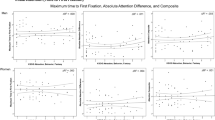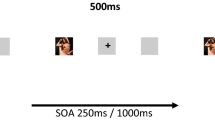Abstract
Individuals who report mostly heterosexual orientations (i.e., mostly sexually attracted to the opposite sex, but occasionally attracted to the same sex) outnumber all other non-heterosexual individuals combined. The present study examined whether mostly heterosexual men and women view same- and other-sex sexual stimuli differently than exclusively heterosexual men and women. A novel eye-tracking paradigm was used with 162 mostly and exclusively heterosexual men and women. Compared to exclusively heterosexual men, mostly heterosexual men demonstrated greater attention to sexually explicit features (i.e., genital regions and genital contact regions) of solo male and male–male erotic stimuli, while demonstrating equivalent attention to sexually explicit features of solo female and female–female erotic stimuli. Mediation analyses suggested that differences between mostly and exclusively heterosexual profiles in men could be explained by mostly heterosexual men’s increased sexual attraction to solo male erotica, and their increased sexual attraction and reduced disgust to the male–male erotica. No comparable differences in attention were observed between mostly and exclusively heterosexual women—although mostly heterosexual women did demonstrate greater fixation on visual erotica overall—a pattern of response that was found to be mediated by reduced disgust.




Similar content being viewed by others
Notes
In Dawson and Chivers (2016), 23 of 53 heterosexual women were predominantly heterosexual; however, no breakdown of the proportion of Kinsey 0’s versus Kinsey 1’s was provided for the 22 heterosexual men in the study. Excluding predominantly heterosexual women from analyses did not change results. Fromberger et al., (2012b) reported including Kinsey 0’s and 1’s in their sample of heterosexual men, and Vásquez-Amézquita et al., (2019) included Kinsey 0’s and 1’s in their sample of gynephilic men and androphilic women. No information on the relative number of each was reported in either study. Lykins et al. (2008), Hall, Hogue, and Guo (2011) and Mitrovic, Tinio, and Leder (2016) reported recruiting self-identified heterosexuals. No information relevant to Kinsey 0 versus 1 status appears to have been collected.
References
Bradley, M. M., Costa, V. D., & Lang, P. J. (2015). Selective looking at natural scenes: Hedonic content and gender. International Journal of Psychophysiology, 98(1), 54–58.
Chivers, M. L. (2017). Response to commentaries. Archives of Sexual Behavior, 46(5), 1213–1221.
Chivers, M. L., Bouchard, K. N., & Timmers, A. D. (2015). Straight but not narrow; Within-gender variation in the gender-specificity of women’s sexual response. PLoS ONE, 10(12), e0142575. https://doi.org/10.1371/journal.pone.0142575.
Cunningham, E., Forestell, C. A., & Dickter, C. L. (2013). Induced disgust affects implicit and explicit responses toward gay men and lesbians. European Journal of Social Psychology, 43(5), 362–369.
Curtis, V., & Biran, A. (2001). Dirt, disgust, and disease: Is hygiene in our genes? Perspectives in Biology and Medicine, 44(1), 17–31.
Dawson, S. J., & Chivers, M. L. (2016). Gender-specificity of initial and controlled visual attention to sexual stimuli in androphilic women and gynephilic men. PLoS ONE, 11(4), e0152785. https://doi.org/10.1371/journal.pone.0152785.
Dawson, S. J., & Chivers, M. L. (2018). The effect of static versus dynamic stimuli on visual processing of sexual cues in androphilic women and gynephilic men. Royal Society Open Science, 5(6), 172286. https://doi.org/10.1098/rsos.172286.
Dawson, S. J., Fretz, K. M., & Chivers, M. L. (2017). Visual attention patterns of women with androphilic and gynephilic sexual attractions. Archives of Sexual Behavior, 46(1), 141–153.
de Jong, P. J., van Overveld, M., & Borg, C. (2013). Giving into arousal or staying stuck in disgust? Disgust-based mechanisms in sex and sexual dysfunction. Journal of Sex Research, 50(3–4), 247–262.
Ebsworth, M., & Lalumière, M. L. (2012). Viewing time as a measure of bisexual sexual interest. Archives of Sexual Behavior, 41(1), 161–172.
Fleischman, D. S., Hamilton, L. D., Fessler, D. M., & Meston, C. M. (2015). Disgust versus lust: Exploring the interactions of disgust and fear with sexual arousal in women. PLoS ONE, 10(6), e0118151. https://doi.org/10.1371/journal.pone.0118151.
Freund, K., Langevin, R., Cibiri, S., & Zajac, Y. (1973). Heterosexual aversion in homosexual males. British Journal of Psychiatry, 122(567), 163–169.
Fromberger, P., Jordan, K., Steinkrauss, H., von Herder, J., Witzel, J., Stolpmann, G., … Müller, J. L. (2012a). Diagnostic accuracy of eye movements in assessing pedophilia. Journal of Sexual Medicine, 9(7), 1868–1882. https://doi.org/10.1111/j.1743-6109.2012.02754.x.
Fromberger, P., Jordan, K., von Herder, J., Steinkrauss, H., Nemetschek, R., Stolpmann, G., & Müller, J. L. (2012b). Initial orienting towards sexually relevant stimuli: Preliminary evidence from eye movement measures. Archives of Sexual Behavior, 41(4), 919–928.
Graham, C. A., Sanders, S. A., & Milhausen, R. R. (2006). The Sexual Excitation/Sexual Inhibition Inventory for Women: Psychometric properties. Archives of Sexual Behavior, 35(4), 397–409.
Haidt, J., McCauley, C., & Rozin, P. (1994). Individual differences in sensitivity to disgust: A scale sampling seven domains of disgust elicitors. Personality and Individual Differences, 16(5), 701–713.
Hall, C., Hogue, T., & Guo, K. (2011). Differential gaze behavior towards sexually preferred and non-preferred human figures. Journal of Sex Research, 48(5), 461–469.
Hayes, A. F., (2013). Introduction to mediation, moderation, and conditional process analysis: A regression-based approach. New York, NY: The Guilford Press.
Hsu, K. J., Rosenthal, A., & Bailey, J. M. (2015). The psychometric structure of items assessing autogynephilia. Archives of Sexual Behavior, 44(5), 1301–1312.
Janssen, E., Vorst, H., Finn, P., & Bancroft, J. (2002). The Sexual Inhibition (SIS) and Sexual Excitation (SES) Scales: I. Measuring sexual inhibition and excitation proneness in men. Journal of Sex Research, 39(2), 114–126.
Kalichman, S. C., & Rompa, D. (1995). Sexual sensation seeking and sexual compulsivity scales: Validity, and predicting HIV risk behavior. Journal of Personality Assessment, 65(3), 586–601.
Lippa, R. A. (2006). Is high sex drive associated with increased sexual attraction to both sexes? It depends on whether you are male or female. Psychological Science, 17(1), 46–52.
Luoto, S., & Rantala, M. J. (2017). Specificity of women’s sexual response: Proximate mechanisms and ultimate causes [Commentary]. Archives of Sexual Behavior, 46(5), 1195–1198.
Lykins, A. D., Meana, M., & Strauss, G. P. (2008). Sex differences in visual attention to erotic and non-erotic stimuli. Archives of Sexual Behavior, 37(2), 219–228.
Meier, B. P., Robinson, M. D., Gaither, G. A., & Heinert, N. J. (2006). A secret attraction or defensive loathing? Homophobia, defense, and implicit cognition. Journal of Research in Personality, 40(4), 377–394.
Mitrovic, A., Tinio, P. P., & Leder, H. (2016). Consequences of beauty: Effects of rater sex and sexual orientation on the visual exploration and evaluation of attractiveness in real world scenes. Frontiers in Human Neuroscience, 10, 122. https://doi.org/10.3389/fnhum.2016.00122.
Morrison, M. A., & Morrison, T. G. (2003). Development and validation of a scale measuring modern prejudice toward gay men and lesbian women. Journal of Homosexuality, 43(2), 15–37.
Moss, F. J. M., Baddeley, R., & Canagarajah, N. (2012). Eye movements to natural images as a function of sex and personality. PLoS ONE, 7(11), e47870. https://doi.org/10.1371/journal.pone.0047870.
Rayner, K. (2009). Eye movements and attention in reading, scene perception, and visual search. Quarterly Journal of Experimental Psychology, 62(8), 1457–1506.
Savin-Williams, R. C. (2017). An exploratory study of exclusively heterosexual, primarily heterosexual, and mostly heterosexual young men. Sexualities, 21(1–2), 16–29.
Savin-Williams, R. C., Rieger, G., & Rosenthal, A. (2013). Physiological evidence for a mostly heterosexual orientation among men. Archives of Sexual Behavior, 42(5), 697–699. https://doi.org/10.1007/s10508-013-0093-1.
Savin-Williams, R. C., & Vrangalova, Z. (2013). Mostly heterosexual as a distinct sexual orientation group: A systematic review of the empirical evidence. Developmental Review, 33(1), 58–88.
Semon, T. L., Hsu, K. J., Rosenthal, A., & Bailey, J. M. (2017). Bisexual phenomena among gay-identified men. Archives of Sexual Behavior, 46(1), 237–245.
Stief, M. C., Rieger, G., & Savin-Williams, R. C. (2014). Bisexuality is associated with elevated sexual sensation seeking, sexual curiosity, and sexual excitability. Personality and Individual Differences, 66, 193–198. https://doi.org/10.1016/j.paid.2014.03.035.
Timmers, A. D., Bossio, J. A., & Chivers, M. L. (2018). Disgust, sexual cues, and the prophylaxis hypothesis. Evolutionary Psychological Science, 4(2), 179–190.
Tybur, J. M., Lieberman, D., Kurzban, R., & DeScioli, P. (2013). Disgust: Evolved function and structure. Psychological Review, 120(1), 65–84.
van Overveld, M., de Jong, P. J., Peters, M. L., van Lankveld, J., Melles, R., & ter Kuile, M. M. (2013). The Sexual Disgust questionnaire; A psychometric study and a first exploration in patients with sexual dysfunctions. Journal of Sexual Medicine, 10(2), 396–407.
Vásquez-Amézquita, M., Leongómez, J. D., Seto, M. C., Bonilla, M., Rodríguez-Padilla, A., & Salvador, A. (2019). Visual attention patterns differ in gynephilic and androphilic men and women depending on age and gender of targets. Journal of Sex Research, 56(1), 85–101.
Author information
Authors and Affiliations
Corresponding author
Additional information
Publisher's Note
Springer Nature remains neutral with regard to jurisdictional claims in published maps and institutional affiliations.
Electronic supplementary material
Below is the link to the electronic supplementary material.
Rights and permissions
About this article
Cite this article
Morandini, J.S., Veldre, A., Holcombe, A.O. et al. Visual Attention to Sexual Stimuli in Mostly Heterosexuals. Arch Sex Behav 48, 1371–1385 (2019). https://doi.org/10.1007/s10508-019-1419-4
Received:
Revised:
Accepted:
Published:
Issue Date:
DOI: https://doi.org/10.1007/s10508-019-1419-4




